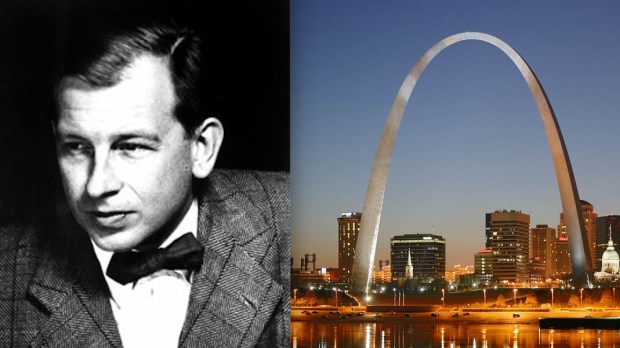Did you know that the designer of the iconic Gateway Arch in St. Louis was an American spy?
Well, in a way.
For a few years during the Second World War, Eero Saarinen, a Finnish-American architect and industrial designer known for his neo-futuristic style, worked for the Office of Strategic Services, the forerunner to the Central Intelligence Agency.
Born in 1910 in Kirkkonummi, in southern Finland, to Eliel Saarinen, a famous Finnish architect, and Loja Saarinen, a renowned textile designer, he grew up in the countryside of the Scandinavian country.
The family moved to Bloomfield Hills, Michigan, in 1923, after Eliel placed second in a competition held by the Chicago Tribune to design the newspaper’s new headquarters building. Eliel was then commissioned to design the Cranbrook Academy of Art, and later became the school’s first president. His son enrolled there and later studied sculpture in Paris. He earned a degree in architecture from Yale University in 1934 and won a scholarship to study in Europe. For a year, he worked in an architectural firm in his native Finland.
But he soon rejoined his father at Cranbrook, this time to teach, work on furniture designs, and compete in architecture contests. The father-son team won a 1938 competition to design the new Smithsonian Gallery of Art, which catapulted Eero to national prominence. The younger Saarinen also won a Museum of Modern art competition in chair design.
Shortly after World War II broke out in Europe, Eero became a naturalized citizen of the United States. According to the public website of the CIA, he was recruited by a former classmate at Yale to join the OSS, even though his native land sided with Nazi Germany against a then-U.S. ally, the USSR:
Eero was appointed Chief of the Special Exhibits Section of the Presentation Division. He was responsible for designing and constructing military schools and situation rooms, along with the display equipment used in the various War Department conference rooms. He created a revolutionary three-dimensional organization chart that was instrumental in presenting problems of procedure and work-flow through various parts of the organization. Eero also used his creative talents to build true-to-scale models. He built models of weapons for use in training scenarios, and he created models and props for use in films.
After the war, Saarinen went on to design the General Motors Technical Center; the TWA terminal at New York’s Idlewild Airport (later renamed JFK); Dulles International Airport in DC; CBS headquarters in New York, and housing at his alma mater, Yale.
But perhaps his best-known design came about after the Jefferson National Expansion Memorial Association held a competition in 1947 for a design that would commemorate the massive flow of pioneers through St. Louis during the 1800s. Eero and his father Eliel entered the competition, individually, thus competing against each other.
Eero won, but he would not live to see the Gateway Arch completed. He died on September 1, 1961, in Ann Arbor, Michigan, while undergoing an operation to remove a tumor from the creative center of his brain. He was only 51.

